#Pre Dreadnought Battleship
Explore tagged Tumblr posts
Text

Coward from 1889 can't handle a butch lady ship in the Age of Steam.
#age of sail#age of steam#1880s#naval history#maritime history#described#imagine not swooning over the beauty of a pre-dreadnought battleship
288 notes
·
View notes
Photo

Pre-'dreadnought' battleships in line ahead formation steaming at speed through the night - Montague Dawson
253 notes
·
View notes
Text
I like how the side profile of metal steamships gradually changed from /_\ to |_| to \_/
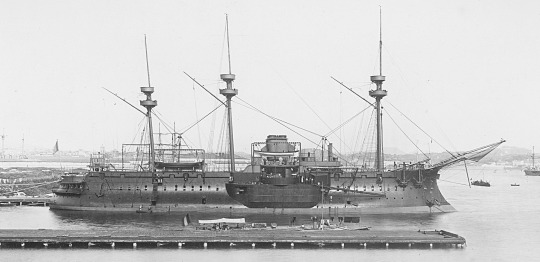


4 notes
·
View notes
Text




I didn't think an AI could make me cry laughing but I'll take the free endorphins
#ascii art#cat#Bard#French pre-dreadnought battleship Charlemagne#I hope this is what you were looking for#Use code with caution#3 weren't enough how about 11#AI#neither artificial nor intelligent
6 notes
·
View notes
Text

Battleships, Battlecruisers, heavy cruisers, coastal defense ships and pre-dreadnoughts of WW2
100 notes
·
View notes
Text

French pre-dreadnought battleship Henry IV in the Dardanelles, ca. 1915
35 notes
·
View notes
Text
what a good day to remember that even though it was a part of the rejected dynamy comic, katsuki just wants to be appreciated with, i quote, all the dreadnought love (someone) has.
brace yourself a second, i'm gonna talk nerdy history talk.
if you don't know: a dreadnought is a battleship classification from the beginning of the 20th century, which was used as the main naval battleship throughout wwi. the namesake comes from the first of its kind, the british navy's hms dreadnought!
but in japanese kanji, it specifies "super-dreadnought". katsuki, first of all, knows his historical classifications. but second, a super-dreadnought is a very loose term coined for ships developed which "outclassed" a dreadnought - starting with the british orion class battleships, circa 1914. they outclassed typical dreadnoughts in size and firepower (and by that i mean their guns were 13.5 inch, compared to 12 inch).
extending on that idea of "super-dreadnought", though: japan had multiple ships that fell under this classification. the main ones i want to mention are the nagato and yamato-class battleships, super-dreadnoughts, which were some of the most powerful ships in the world for a very long time. (the nagato-class was completed post-wwi, the yamato-class was completed pre-wwii.) their firepower completely outshone any predecessors; remember, the first super-dreadnoughts had 13.5 inch guns. WELL. the nagato-class had 16.1 inch guns, while the yamato-class had 18.1 inch guns, to compare.
"so cam what the FUCK are you getting at," you may ask. i swear i have a point here!
katsuki is saying that if you're going to love him, it should be with the entire firepower of a super-dreadnought battleship. and knowing katsuki, he's not just saying a single measly pre-wwi dreadnought battleship; remember, he said super-dreadnought in kanji. if we indulge in my headcanon that he's the BIGGEST history buff, he's likely alluding to the yamato-class battleship.
you know, the battleship with approximately nine naval artillery guns, twelve dual-purpose turrets, twelve anti-aircraft guns, twenty-seven automatic anti-aircraft cannons, and four anti-aircraft heavy machine guns, on top of aircraft launch capabilities........
so anyway tl:dr love is war and he demands it as such.
#💥 ⸍ i. out.#💥 ⸍ ii. headcanon.#long post /#/ this is in the spirit of v.alentine's day! i'm struggling with memes#/ me rattling the bars of my cage every time i get to talk history:#/ he makes me laugh every time tho like u are not subtle man .....#/ with move names like howitzer n strafe panzer he's a NERD.#/ maybe someone should take him to see any of the memorial ships#/ he wouldn't say anything during but he'd never shut up abt it after#/ ... damn i just realised he'd actually like to do that as a date thing
7 notes
·
View notes
Text
Star Wars Technical Worldbuilding Notes 5
Considering the timescales of galactic history, I think in some cases it makes a certain amount of sense that the aliens look so much like humans because they literally evolved with attractiveness to humans as a natural selection factor. Nowhere near all cases, of course.
I've been thinking of headcanoning the XJ5 ChaseX as just an XJ that had the hyperdrive and some shielding yanked out to cut mass, giving a cheap stopgap design of a short-range patrol fighter and mediocre-at-best interceptor. This would have originally been to replace losses in the immediate aftermath of the Yuuzhan Vong War, but it was successful enough to still be seen as a patrol fighter in LotF and FotJ.
At the end of Abyss, in the chase scene that's also the only appearance of the Nargi-class pursuit frigate, Han expects the ChaseXs that are there to be carrying ion torpedoes, implying those are XJ5s' standard loadout.
YT-5100 Shrieks, I think, exist for similar reasons. Potential war against the GA was anticipated by CEC executives (who, for whatever it's worth, may or may not have known about Thrackan's assault fleet) and a bomber made from ubiquitous YT-series components would be very fast and cheap to produce and train pilots on. Theoretically, another advantage would be that they could easily be assembled in secret, but Wedge does say the GA knows of the YT-5100s' specs, so if they were trying to do that, they failed.
For better or for worse, the X-Wing books are one of my biggest influences in terms of how I interpret Star Wars. I don't buy for a second, of course, that it takes a week or more to make a squadron of X-Wings, but for post-FotJ Jedi stories with StealthXs, figures like that make somewhat more sense.
Particularly because there still can't be more than a thousand Jedi in the galaxy at that point (Approximately 700, is my headcanon) and finding skilled pilots would be at least as big of a deal as replacing the ships.
At this rate, I think I'm going to straight up retcon the Anakin Solo as a Galactic-class destroyer, because KDY still building Imperators at that point in the timeline makes no goddamn sense.
Sometimes I do wonder about exactly what organizations are responsible for manufacturing Imperial warships by the time the biggest shipyard they have is Yaga Minor.
In the kind of galactic scale paradigm that holds "star destroyer" and "star dreadnought" as comparable classification levels to what a destroyer and a battleship are in Earth navies of the last 50 years or so, the word "cruiser" being applied to ships like Dreadnaughts and Carracks, which are effectively frigates at best, is often explained as the result of those ships having been intended to be sold to smaller planetary/system forces where a Dreadnaught would have been on the mid/high end of the ships those navies could buy and operate.
Those examples in particular are pre-Clone Wars designs, from a time where most of the galaxy's overall military strength would have been tied up in those kinds of forces, since there wasn't a centralized military.
And if a 1e24-watt "cruiser" reeks of low-budget PDF marketing, the word "blastboat" absolutely oozes of that energy.
1 note
·
View note
Text

HMS Majestic, pre-dreadnought battleship of the Royal Navy
British vintage postcard
#historic#briefkaart#postkaart#majestic#british#carte postale#royal navy#ephemera#dreadnought#tarjeta#photo#navy#postcard#postal#royal#postkarte#ansichtskarte#battleship#hms majestic#sepia#photography#vintage
5 notes
·
View notes
Photo
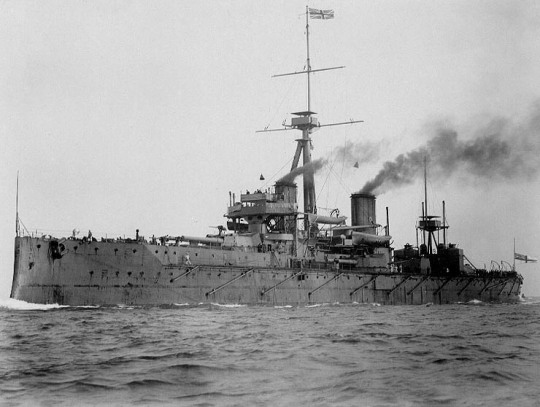
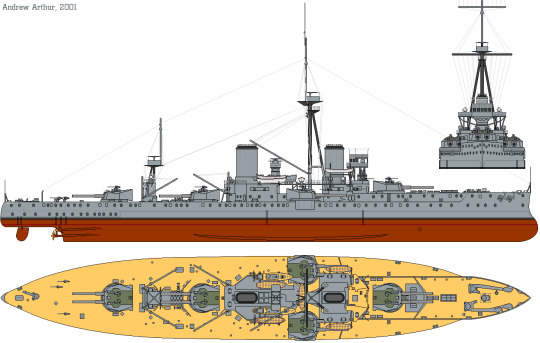
HMS Dreadnought was a Royal Navy battleship whose design revolutionised naval power. The ship's entry into service in 1906 represented such an advance in naval technology that her name came to be associated with an entire generation of battleships, the "dreadnoughts", as well as the class of ships named after her. Likewise, the generation of ships she made obsolete became known as "pre-dreadnoughts". Admiral Sir John "Jacky" Fisher, First Sea Lord of the Board of Admiralty, is credited as the father of Dreadnought. Shortly after he assumed office in 1904, he ordered design studies for a battleship armed solely with 12 in (305 mm) guns and a speed of 21 knots (39 km/h; 24 mph). He convened a "Committee on Designs" to evaluate the alternative designs and to assist in the detailed design work.
Dreadnought was the first battleship of her era to have a uniform main battery, rather than having a few large guns complemented by a heavy secondary armament of smaller guns. She was also the first capital ship to be powered by steam turbines, making her the fastest battleship in the world at the time of her completion.[1] Her launch helped spark a naval arms race as navies around the world, particularly the Imperial German Navy, rushed to match it in the build-up to the First World War.[2]
Ironically for a vessel designed to engage enemy battleships, her only significant action was the ramming and sinking of German submarine SM U-29; thus she became the only battleship confirmed to have sunk a submarine.[3] Dreadnought did not participate in the Battle of Jutland in 1916 as she was being refitted. Nor did Dreadnought participate in any of the other First World War naval battles. In May 1916 she was relegated to coastal defence duties in the English Channel, before rejoining the Grand Fleet in 1918. The ship was reduced to reserve in 1919 and sold for scrap two years later.
https://en.wikipedia.org/wiki/HMS_Dreadnought_(1906)
6 notes
·
View notes
Text
25 June 2023
Consigned to the Deep
Gallipoli 25 June 2023
The battleships that made up Admiral John de Robeck’s fleet on the 18th of March 1915 weren’t really the apex of the British and French navies. Apart from the ultra-modern Queen Elizabeth, a ‘super-dreadnought’ with fifteen inch guns, and the battlecruiser Inflexible, the fleet was a bit like entering a fleet of VW Beetles into a V8 Supercars race at Bathurst. These old battlewagons - ‘pre-dreadnoughts,’ as they predated the revolutionary HMS Dreadnought which was faster, hardier and better armed then all that came before her - were elderly, almost geriatric in naval terms. The French Bouvet dated back to 1893.
Nevertheless, even old battleships can make a considerable impression when one has eighteen of them, and on that March day, de Robeck hoped to utilise his apparently superior firepower to blast the Turkish forts covering the ‘Narrows,’ while civilian ships swept the mines blocking his path. Once through the Dardanelles, he would be into the Sea of Mamara, with only the German-crewed battlecruiser Yavuz, formerly Goeben, between his fleet and the Bosphorous. They would place Constantinople under the guns and force the surrender of the Ottoman Empire.
It is this day that the Turkish people commemorate - not the 25th of April. Here, the Ottoman defenders in the forts and on the howitzers covering the Narrows stared down the might of the most powerful navies in the world and held them off. Precious battleships were badly damaged, as was Inflexible. Bouvet hit a mine and was lost with all but seventy-five of her crew. HMS Ocean, moving to assist, was struck by shellfire and further mines and had to be abandoned, as was HMS Irrestable. Far from an easy victory, the Naval Battle of the Dardanelles had become an expensive setback.
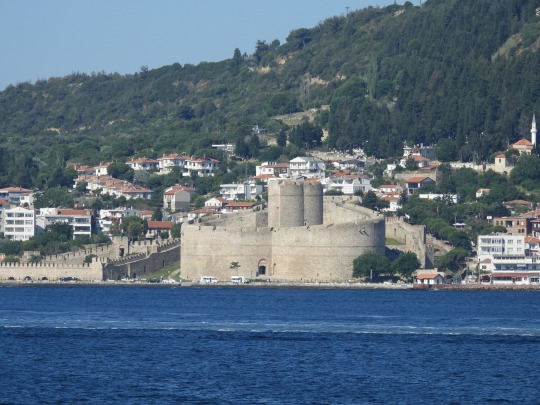
In truth, the British were breaking a key rule of naval warfare, one set down by Lord Nelson himself - ‘a ship’s a fool to fight a fort.’ You do not send your ship to fight a gunnery duel with fortifications - that is what your marines are for. Like everything else about this squalid campaign, the effort of the 18th of March was doomed. This does not invalidate the bravery of the Turks, nor does it denigrate their performance, particularly in quickly moving artillery to protect it from naval gunfire. It’s simply another example of the almost criminally haphazard planning of the operation.
This was a very longwinded way to tell you that I crossed the Narrows today, isn’t it?
The town of Canakkale sits on the Asian side of the Dardanelles - the Gallipoli Peninsula is on the European side, on that little bit of Turkey that borders Greece and Bulgaria. (This was actually important during the war - the entry of Bulgaria into the war on Germany’s side in October 1915 was one of the last nails in the coffin of the Gallipoli campaign, and troops were now sent to join the even more idiotic campaign at Salonika in Greece.) To get there from Gallipoli, one has to cross via car ferry, which gives excellent views of the landscape around the Narrows. If you listen carefully as you look at the preserved forts, you can hear Nelson rolling in his grave.
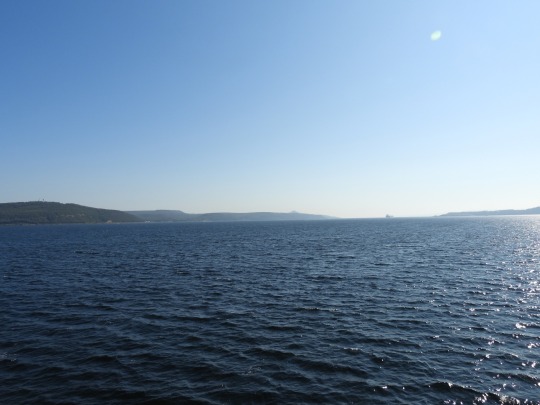
We reached the Asian side of the Dardanelles around 9.30 and drove a little way out of town to the (alleged) site of Troy. (I say ‘alleged’ of course because we don’t really know if this is actually, or if Troy actually existed. My theory is that Homer conflated a number of towns and conflicts into ‘Troy’ and ‘the Trojan War.’ Or he might have just been wrong - Homers aren’t known for being smart.) My verdict on the site? Well, there’s bricks. There’s holes. There’s bricks in holes. There was definitely a city here once, but most of what we can say about it is educated guesswork. So I looked at these bricks, I said ‘yep,’ and then I went to the cafe and had an ice cream. That was my adventure in Troy - my Troy Story, if you will.
(I’ve always preferred Woodyseus to Oddyseus anyway.)
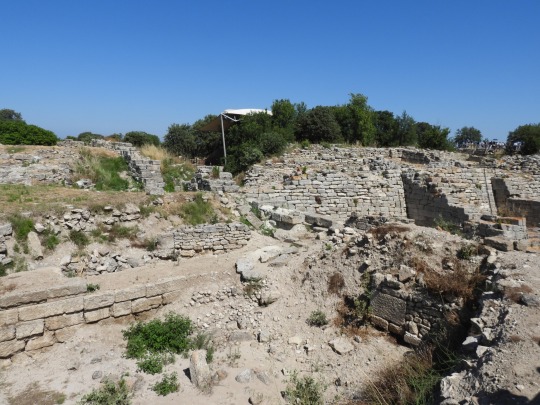
We returned to Cannakkale and were unleashed upon the town for a few hours, so naturally I found a naval museum. This is based around an old fort that dates from the reign of Mehmet the Conquerer - the fifteenth century sultan who captured Constantinople and destroyed the last remnant of the Eastern Roman Empire. The grounds now serve as a staging post for an eclectic mix of naval and land artillery, mines, torpedoes and even the skeleton of a First World War German U-Boat, recovered from the deep. There’s also a fibreglass replica of the minesweeper Nusret, but quite alarmingly I couldn’t find it. I sincerely hope the museum remembered to tie it up, or it might be halfway to Malta by now.
Inside the keep is a Turkish museum about the Gallipoli campaign. It isn’t terribly modest, and I noted a few errors (a diorama of W Beach seems to be mislabelled as V Beach), but it didn’t strike me as too odd to see a museum in which ‘we’ are the bad guys. If one changed the word ‘martyred’ for ‘sacrified,’ and the word ‘Turkish’ for ‘Anzac,’ this could be a wing in an Australian museum. There was also a little more music than a comparable museum in Australia - at least for now, the last thing we want to do is give the AWM ideas. (I remember the First World War gallery having this sad song playing over the exit for a while - it was meant to be evocative, but all it really evoked was the sensation of having your eardrums blasted out any time you dared to go near the 1918 section. It was the equivalent of having Brendan Nelson smash you over the head with a shovel while screaming at you to feel ‘proud but sad.’)

We headed back to Gallipoli at around 4pm. I rested for a while. Maddi did not, as she and our professor reconnitered Rhododendron Ridge to test it’s viability for a group walk. We had meant to do Walker’s Ridge, but erosion in that area has become so great that it barely exists anymore, and walking it in any numbers would have been impossible. Rhododendron, the path the New Zealanders walked to Chunuk Bair, was the alternative, and the scout party found it workable. Maddi’s reward was to go right back to Chunuk Bair, join the group, and do it all again.
Our professor, I must add, is about sixty-seven years old. He has the energy of someone a tenth of his age. This leads to the absurd image of a mild-mannered bespectacled man with grey hair leaping and bounding over the most precarious ground ahead of a whole group of exhausted, sweaty twenty-somethings who can’t navigate a small bump in the track without slowing to a crawl. He would be standing on the narrowest, wildest part of the trail, motioning us forward as if we were strolling the Strand, and I’d be fifty meters back contemplating calling for a surgeon to saw off both my legs.
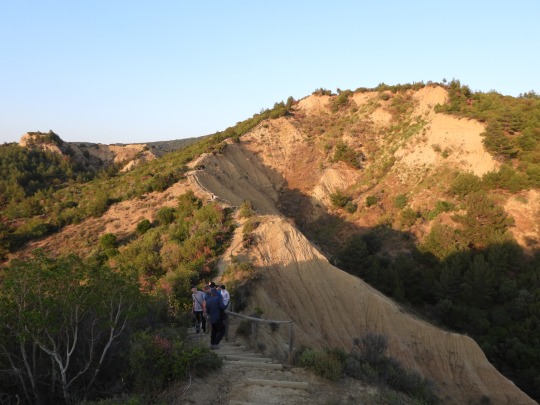
The walk, arduous though it was, was absolutely stunning, with amazing views of Monash Valley, the Nek, and out towards both Anzac Cove and Suvla Bay. It’s littered with the detritus of the campaign - we found a button from an Australian soldier’s tunic and a rum bottle buried in the ground. Both of these we left. Our professor is of the opinion that the relics found at Gallipoli should stay where they were found. I’m personally conflicted. I think some of this should be preserved so that they don’t simply rust away, but I’m also aware that - as Bean himself said - the whole of Gallipoli is one massive grave, and perhaps taking them to a museum could be considered grave-robbing. I suppose it depends on your morals.
I would be remiss if I didn’t mention our scout here - Lance-Corporal Nigel, who journeyed with us all the way from Chunuk Bair to the sea.

We ended at the Embankment Cemetary, returned to the bus, and headed back to base. My feet hurt and I think I’ll be picking brambles out of my socks for days (even accounting for my wearing of cargo pants), but I’m very glad I did the walk. I think ordeal is often a part of visiting battlefields - if they could fight here, the least we can do is shed a little sweat. But my body yearns for a soft bed, and I can no longer deny it, so we’ll leave this for tonight here.
2 notes
·
View notes
Text

US Navy Pre-Dreadnought Battleship USS Iowa BB-4.
3 notes
·
View notes
Text
Spinning Sky Rabbit
KM KzS L, 02/29/2020
Choreography: ATY
Distribution Video
Password Hint Translation: "The date in which the Mecklenburg, a pre-dreadnought Wittelsbach class battleship, was stricken from the navy list. Note: 8 digits in total.
Note: You must contract the creator before using this motion in any fanmade concerts or similar events.
4 notes
·
View notes
Note
can you deadass just ramble about an event in history you find fascinating and/or something you find fascinating,
o7
The Battle of Jutland!


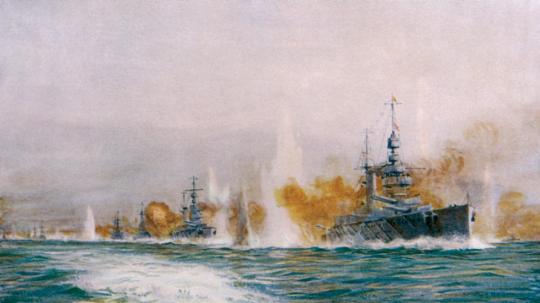
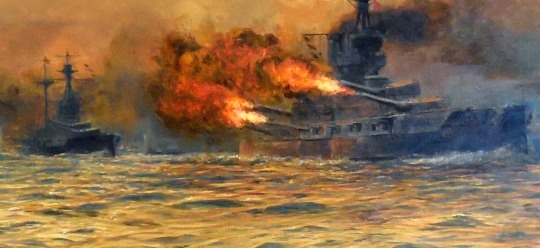

250 combat ships, 151 British and 99 German, basically both navies as a whole facing each other, in which British naval supremacy was tested in her own waters for the last time directly, and where all the naval ambitions of a relatively young German empire were effectively crushed.
A massive slog that marked the height of the era of the battleship, becoming the last major naval battle in which air assets played no role, although not because of a lack of trying, as both sides deployed what they had, Germany Zeppelins and Britain sea planes, to no avail.
Among other things, this battle downplayed the almost phobic fear of torpedoes, demonstrated that both armored cruisers and pre-dreadnought battleships had become effectively useless, and showed that if you don't put quality over quality, you lose three battlecruisers in exchange for your shell not detonating properly, the one true reason why the German High Seas Fleet managed to eventually escape.
69 notes
·
View notes
Text

French pre-dreadnought battleship Jauréguiberry
11 notes
·
View notes
Text

French battleship Richelieu's quadruple turrets cross section. These were the most powerful weapons developed by the Marine Nationale for their battleships.
Posted on the "The Dreadnought and Pre-Dreadnought Battleships Society" Facebook page: link
#French Battleship Richelieu#Richelieu Class#Richelieu#French Battleship#Battleship#warship#ship#cross section#cutaway#french navy#la royale#marine nationale#my post
37 notes
·
View notes